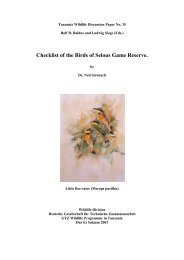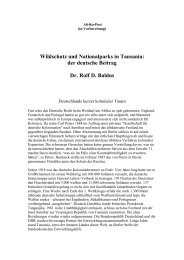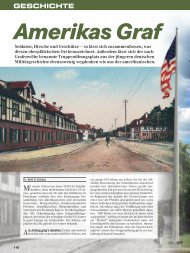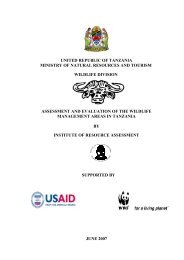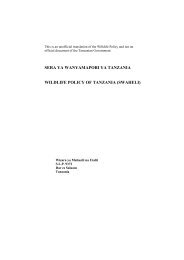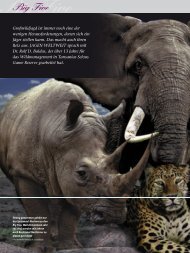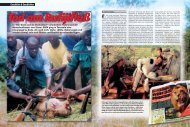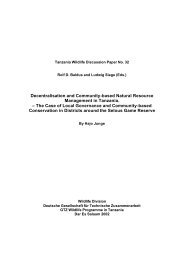African Indaba Articles - wildlife-baldus.com
African Indaba Articles - wildlife-baldus.com
African Indaba Articles - wildlife-baldus.com
You also want an ePaper? Increase the reach of your titles
YUMPU automatically turns print PDFs into web optimized ePapers that Google loves.
‘poaching’ reflects a far older situation going back into Kenya’s distant past. Late in the colonial era,it became appreciated that the negative approach to <strong>wildlife</strong> use was failing — colonial reaction to<strong>African</strong> <strong>wildlife</strong> use was one of preventing <strong>African</strong>s from using <strong>wildlife</strong> [editor’s emphasis].The first clear evidence of the failure of the colonialists’ obstructive policy as far as <strong>African</strong>s’ use of<strong>wildlife</strong> was the creation of the Galana Game Management Scheme, closely followed by weak and halfheartedmeasures that allowed landowners to use wild animals <strong>com</strong>mercially. Land owners were allowed tosell trophies, but not meat, or meat but not trophies. The policies sputtered and fizzled erratically afterindependence. Today the arguments for and against legitimate <strong>wildlife</strong> use do not reflect more than thesituation that has persisted since the colonial era.The big difference that has taken place over time, however, is that the <strong>wildlife</strong> resource is now afraction of what it once was, and declines steadily."This archaic approach to <strong>wildlife</strong> management has led to an unending human-<strong>wildlife</strong> conflict.In a paper titled, The status and challenges of human-<strong>wildlife</strong> conflict in Kenya: Novel and practicalapproaches towards mitigation, Dr Geoffrey Wahungu, a senior lecturer at Moi University’s WildlifeDepartment, argues that there are no models that have been developed from data collected or existinginformation to help predict and develop early warning systems or <strong>com</strong>pile conflict mitigation measures foradoption and implementation. He adds that the methods applied now are not well documented, their relativeefficiency and practicality of application undetermined and their potential in mitigating the conflict unknown.In the paper, Wahungu documents approaches used to mitigate conflict to minimize conflict and at thesame time conserve <strong>wildlife</strong> resources and save people’s livelihoods. Although the <strong>com</strong>munities living aroundnational parks lose lives, limb and property among other burdens such as pests and diseases that <strong>wildlife</strong>spread to their livestock, they do not enjoy profits accruing from <strong>wildlife</strong> in the same proportion.It is irrational to ask people affected negatively not to kill animals that destroy their crops or killand maim residents. Farmers near <strong>wildlife</strong> conservation areas suffer loss of crops, but do not get<strong>com</strong>pensated. They only get a consolation. To such farmers, <strong>wildlife</strong> conservation means lost crop,which translates to lost food or in<strong>com</strong>e. For conservation to work, <strong>wildlife</strong> should make a positiveimpact on the <strong>com</strong>munities’ bottom line [editor’s emphasis].Some Thoughts about Trophy Hunting and Hunting TrophiesBy Basie Maartens, Past President PHASA“Trophy Hunting and Hunting Trophies”, that is how Gerhard Damm put it when he asked me to submitan article regarding the 54 th CIC General Assembly in Belgrade. To me it seems that both are the same.What needs to be examined are the words ‘hunting’ and ‘trophies’.So we will not explore the skull of the lion or the boss of the buffalo, what it measures or how hard itis, these are details which will be dealt with by the hunter who actually hunts (and not just shoots) theanimal. Rather how it was obtained –for that we need some clarification, and examination, of the philosophyof hunting.Hunting needs to be clearly defined, and one should not use the word incorrectly. For instance,“culling” is not hunting, nor is “harvesting” or “taking” of an animal. These are euphemisms used for killing orshooting. There are people who are afraid of using the right word or would consider it politically incorrect andwant to disguise what they are actually doing. There is no reason for a hunter to make excuses for what he isdoing, providing it is in fair chase.To give a definition to ‘hunting’ has racked my brain but I have <strong>com</strong>e up with the following: “Hunting isthe pursuit of an animal in fair chase and its ethical killing in a humane manner for a recognized purpose.”In the case of trophy hunting, the recognized purpose is to collect a trophy. Robert Ruark said: “I shoothim when he is ready for heaven and his tusks are the monument, as the Cross is revered in Christ’s name.When I shoot an old elephant, I shoot the memory of a man and my particular hope of heaven, which is to beput down at the ultimate prime time, by any man – or beast – like me.”152



